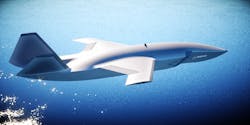PhysicsAI to develop artificial intelligence (AI) algorithms for high-performance unmanned combat aircraft
ARLINGTON, Va. – U.S. military researchers are asking artificial intelligence (AI) experts at PhysicsAI in Pacifica, Calif., to develop AI algorithms to enable future experimental high-performance unmanned combat aircraft to formulate teams of manned and unmanned jet fighters.
Officials of the U.S. Defense Advanced Research Projects Agency (DARPA) in Arlington, Va., announced a $2.3 million contract to PhysicsAI earlier this month for the Air Combat Evolution (ACE) Technical Area 1: Build Combat Autonomy project.
This project seeks to increase warfighter trust in combat autonomy by automating aerial within-visual-range maneuvering using realistic aircraft.
The ACE Build Combat Autonomy project seeks to advance AI technologies for individual and team aerial dogfighting tactics. To do this, DARPA wants PhysicsAI to develop an aircraft autonomy able to move to progressively more realistic environments, including live subscale unmanned aerial vehicles (UAVs), and ultimately to full-scale combat aircraft.
The project will develop air combat maneuvering algorithms for within-visual-range air combat maneuvering that involve one-versus-one, two-versus-one, and two-versus-two engagements against adversaries with a broad spectrum of performance.
The ACE program overall seeks to increase trust in combat autonomy using human-machine collaboration in aircraft dogfighting, as well as develop enabling technologies to enhance collaboration among humans and unmanned combat aircraft in a variety of combat scenarios.
The idea is to enable one human pilot to become a more deadly warfighter by leading several semi-autonomous artificially intelligent unmanned aircraft, all from his own cockpit. This would shift the human role from sole operator to system mission commander.
In particular, ACE aims to enable a pilot to handle a broad, global air command mission while his aircraft and unmanned aircraft team members attack enemy aircraft and ground targets.
For more information contact PhysicsAI online at https://physics-ai.com, or DARPA at www.darpa.mil.

John Keller | Editor-in-Chief
John Keller is the Editor-in-Chief, Military & Aerospace Electronics Magazine--provides extensive coverage and analysis of enabling electronics and optoelectronic technologies in military, space and commercial aviation applications. John has been a member of the Military & Aerospace Electronics staff since 1989 and chief editor since 1995.

